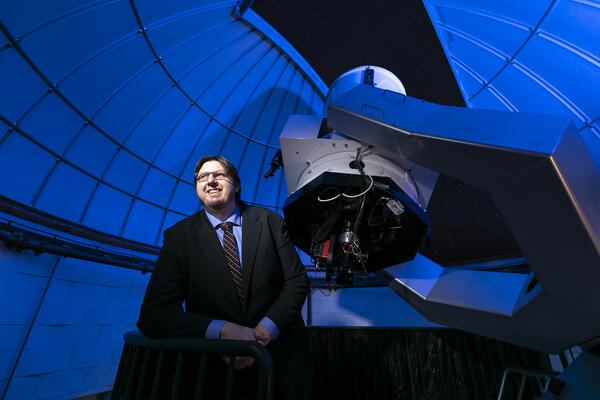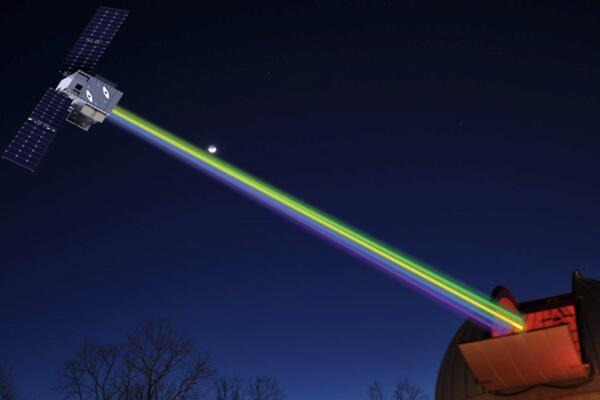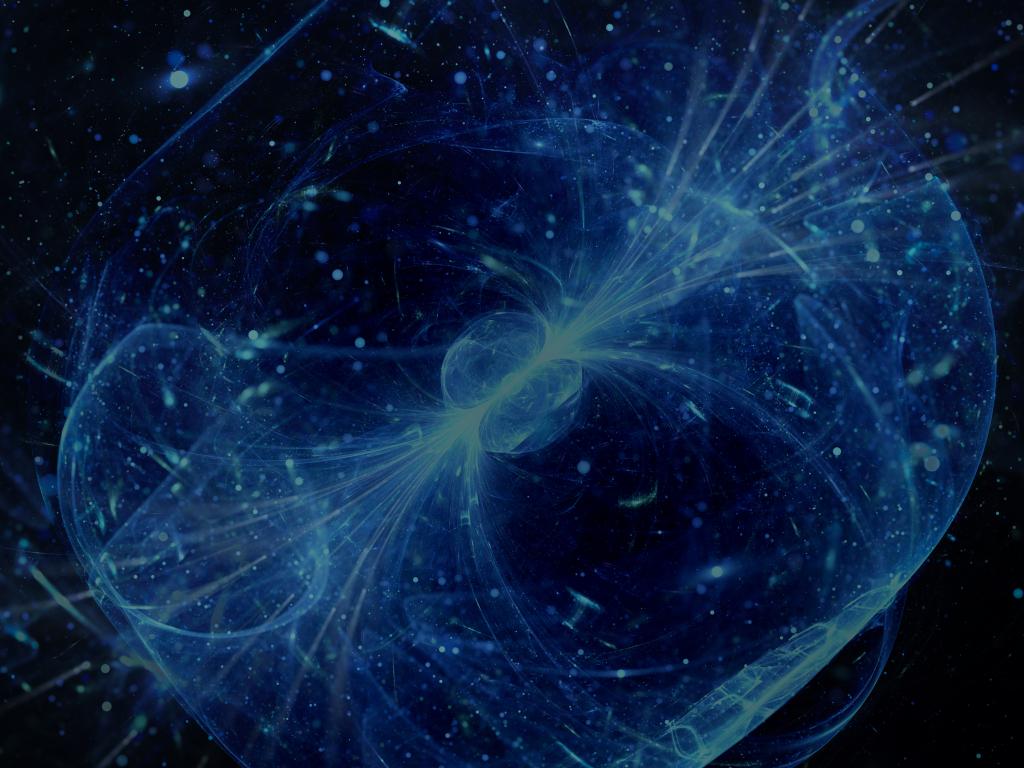Admission CTAs
George Mason University announces its first NASA Space Mission which seeks to uncover the secrets of dark energy

George Mason University will be the home of the $19.5 million recently approved Landolt NASA Space Mission that will put an artificial “star” in orbit around the Earth. This artificial star will allow scientists to calibrate telescopes and more accurately measure the brightness of stars ranging from those nearby to the distant explosions of supernova in far-off galaxies. By establishing absolute flux calibration, the mission will begin to address several open challenges in astrophysics including the speed and acceleration of the universe expansion.
"This mission marks another first for George Mason University, a milestone that proves our impact as a major public research university truly knows no bounds,” George Mason University President Gregory Washington said. “It's an honor for George Mason to lead this unique team seeking to expand the boundaries of knowledge through College of Science associate professor Peter Plavchan’s collaboration with NASA, one of George Mason's most prestigious research partners.”
Scientists know the universe is expanding, which is measured by calculating the brightness of numerous stars and by the number of photons-per-second they emit. According to Plavchan, a George Mason associate professor of physics and astronomy and the Landolt Mission principal investigator, more accurate measurements are needed for the next breakthroughs.
Named for late astronomer Arlo Landolt, who put together widely used catalogs of stellar brightness throughout the 1970s through the 1990s, this mission will launch a light into the sky in 2029 with a known emission rate of photons, and the team will observe it next to real stars to make new stellar brightness catalogs. The satellite (artificial star) will have eight lasers shining at ground optical telescopes in order to calibrate them for observations. The effort will not make the artificial stars so bright as to see with the naked eye, but one can see it with a personal telescope at home.
“This mission is focused on measuring fundamental properties that are used daily in astronomical observations,” said Eliad Peretz, NASA Goddard mission and instrument scientist and Landolt’s deputy principal investigator. “It might impact and change the way we measure or understand the properties of stars, surface temperatures, and the habitability of exoplanets.”

The artificial star will orbit earth 22,236 miles up, far enough away to look like a star to telescopes back on Earth. This orbit also allows it to move at the same speed of the Earth’s rotation, keeping it in place over the United States during its first year in space. “This is what is considered an infrastructure mission for NASA, supporting the science in a way that we’ve known we needed to do, but with a transformative change in how we do it,” Plavchan explained.
The payload, which is the size of the proverbial bread box, will be built in partnership with the National Institute of Standards and Technology (NIST), a world leader in measuring photon emissions. “This calibration under known laser wavelength and power will remove effects of atmosphere filtration of light and allow scientists to significantly improve measurements,” explained Peter Pachowicz, associate professor in Mason’s Department of Electrical and Computer Engineering, who is leading this component of the mission.
George Mason faculty and students from Mason’s College of Science and College of Engineering and Computing will work together with the NASA and NIST and nine other organizations for a first-of-its-kind project for a university in the Washington, D.C., area. Pachowicz added, “This is an incredibly exciting opportunity for George Mason and our students. Our team will design, build, and integrate the payload, which—because it’s going very high into geostationary orbit—must handle incredible challenges.”
With mission control based at George Mason on its Fairfax Campus, the team also includes Blue Canyon Technologies; California Institute of Technology; Lawrence Berkeley National Laboratory; Mississippi State University; Montreal Planetarium and iREx/University of Montreal; the University of Florida; the University of Hawaiʻi; the University of Minnesota, Duluth; and the University of Victoria.
With more accurate measurements, experts will use the improved data from the project to enhance understanding of stellar evolution, habitable zones or exoplanets in proximity to Earth, and refine dark energy parameters, setting a foundation for the next great leaps in scientific discovery. “When we look at a star with a telescope, no one can tell you today the rate of photons or brightness coming from it with the desired level of accuracy,” Plavchan, who is also the director of Mason’s Observatories in Fairfax, said. “We will now know exactly how many photons-per-second come out of this source to .25 percent accuracy.”
"Flux calibration is essential for astronomical research.” explained NIST’s Susana Deustua, a Physical Scientist in the NIST Remote Sensing Group. “We constantly ask: ‘How big? How bright? How far?’ and then ponder: ‘What is the universe made of? Are we alone?’ Accurate answers require precise measurements and excellent instrument characterization,” Deustua said.
Learn more at https://landolt.gmu.edu.
Media Inquiries:
John Hollis: 571-396-1578, jhollis2@gmu.edu
Tracy Mason: 703-229-2030, tmason11@gmu.edu
Nathan Kahl: 301-675-8889, nkahl@gmu.edu
Partners weigh in on the magnitude and opportunity with this critical Landolt Mission:
NIST scientists S. Deustua, J. Rice, and B. Alberding will apply their expertise to the calibration of Landolt-emitted light. This will be critical, as precise calibration enables astronomers to better answer pressing questions like: “Are there other Earths? What is the history of the Universe?"
"Major new telescopes – like NASA’s Nancy Grace Roman Space Telescope and the Vera C. Rubin Observatory – intend to measure the expansion history of the universe using the brightnesses of supernovae. However, errors in brightness calibration across wavelengths could lead to incorrect measurements. Landolt will solve this problem by providing telescopes with light of known brightness," said Greg Aldering of the Berkeley Lab's Physics Division, who will serve on the Landolt science team to ensure that it is designed and performs as needed for precision cosmology measurements. Once the Landolt satellite is in orbit, Aldering and his team plan to observe the calibrated light from Landolt with ground-based instruments, including the SuperNova Integral Field Spectrograph (SNIFS) in Hawaii, built in part by Berkeley Lab, and the Vera C. Rubin Observatory in Chile, equipped with a 3.2 billion pixel camera built by DOE.
“Being a part of this space mission along with brilliant experts by contributing to target selection and data analysis is an exciting prospect,” said Canada’s Jonathan Gagné, scientific advisor at the Planétarium | Montréal Space for Life, adjunct professor at Université de Montréal, and member of the Trottier Institute for Research on Exoplanets (iRex). “The impact that the Landolt mission will have in different areas of astrophysics, notably in exoplanet characterization and in measuring the accelerating expansion of the Universe, will be particularly important,” Gagné explained.
"The measurements by Landolt will enable tremendous progress for a wide range of ground-based astronomical observations,” said Daniel Huber, associate professor at the University of Hawaiʻiʻs Institute for Astronomy. The University of Hawaiʻi will provide access to the UH88 telescope located atop of Maunakea, Hawaiʻi, one of the ground stations that will observe Landolt during its mission. Maunakea is one of the best sites for ground-based astronomy in the world.
“The University of Victoria is excited to be an institutional collaborator on the NASA Landolt mission. We will leverage what we've learned from the CSA-funded, UVic-led ORCASat CubeSat satellite mission and are greatly looking forward to contributing to the success of this new mission,” said Justin Albert, professor of physics and astronomy at University of Victoria.
“This project is tackling a truly fundamental problem in astronomy in a very novel way,” said Dan Stevens, PhD, an assistant professor of Astronomy at the University of Minnesota Duluth. “By creating an "artificial star,” measuring its brightness in the laboratory, and launching it into space, our team will then be able to take lab-calibrated measurements of real stars' actual, absolute brightnesses. This level of accuracy wasn’t possible before, and it will allow us to overcome decades-long sources of uncertainty in how well we measure the fundamental properties of stars and the planets they host.”
“Landolt is an exciting opportunity to enable absolute calibration in astronomy at an unprecedented level,” said David Ciardi, Chief Scientist for NASA Exoplanet Science Institute (NExScI) at Caltech/IPAC. “For as long as people have looked up at the night sky, a fundamental question has always been: ‘What is the true brightness of that star?’ Landolt has the opportunity to change astronomy for the relatively minimal cost of a NASA Astrophysics Pioneer program,” Ciardi explained.
NExScI, responsible for the Landolt data archiving and contributing to the ground support through Palomar Observatory suggests, “Even with today’s modern instruments, true brightness calibration has only been good to a few percent, and Landolt will enable an improvement by more than a factor of 10. Understanding the true brightness of stars allows to understand the stars better – and, perhaps more importantly, understand the planets that orbit the stars better.
Learn more about the Landolt NASA Space Mission
Discover additional details surrounding the Landolt NASA Space Mission and meet the team leading efforts to put an artificial “star” in orbit around the Earth. This will allow scientists to calibrate telescopes and more accurately measure the brightness of stars ranging from those nearby to the distant explosions of supernova in far-off galaxies.

